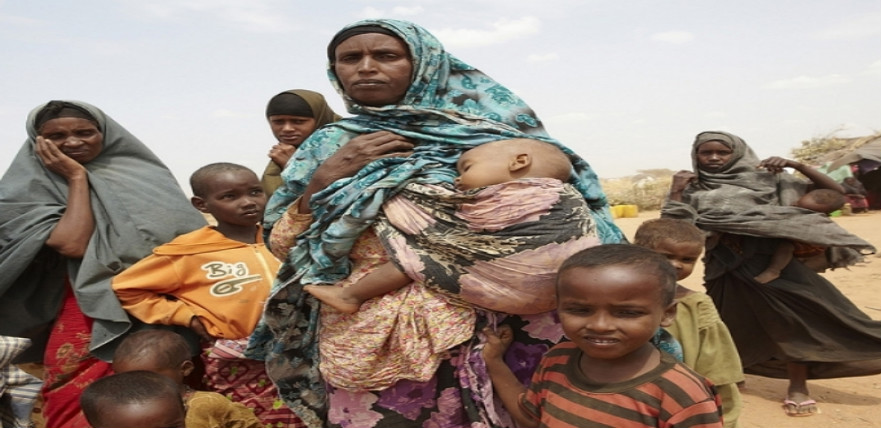A human migration that started more than a month

A table made of bits and pieces, an old notebook, green crumbling walls: this is where Luul Mohamed, the 46-year-old head of the pediatrics department at Banadir Hospital in Mogadishu examines a hundred children every day.
Sheesam comes in with her mother. She has a loose cough and might suffer from malaria. She is four years old but weighs just 28 pounds. Here children never come in with the normal weight and size for their age. “Ninety children died last month, that’s three children per day,” says the woman everyone calls ‘Doctor Luul.’
Twenty years of civil war have weakened the population, making famine even more problematic. “There are more famine-related diseases, more sick children in one family, more people affected,” she says.
Pandemics spread because of mass internal migrations and the sinking economic activity means there’s no work or money to pay for treatments. “Do you know how old the hospital’s X-ray machine is?” asks Ahmed Adam. “It’s half a century old.”
This Sudanese man came from Mogadishu four months ago to take over the humanitarian action department of the Organization of Islamic Cooperation (OIC). He’s seen many crises: Darfur, Sierra Leone, Eritrea. “But this one is very special because of its severity and because there’s no control on the national level,” he says.
The OIC is hoping to improve conditions at Banadir Hospital through a 5-million-dollar rehabilitation program aimed at training staff, improving sanitation – blood is stored in an old fridge – and setting up action protocols for each department. Earlier this month a group of 21 doctors, experts and professors from several Islamic countries arrived with 45 tons of medical equipment.
For now, however, the facility remains in an incredibly precarious state. “There’s only one water pump in Banadir Hospital. If it breaks down, it will be a disaster,” says Mr. Adam. For now, nurses are volunteers because there is no state to pay them.
“There are no resources, no management and no equipment,” adds Doctor Ifftikar, head of the Islamic Relief (IR) for Somalia. Every day, three IR ambulances drive around the city and take about 20 children back to Banadir Hospital. IR has also provided medicine and set up an in-hospital treatment center for people suffering from diarrhea.
IR, along with some 20 Turkish, Qatari and Kuwaiti humanitarian agencies, work under the OIC umbrella, the world’s second largest inter-governmental organization after the UN. They meet up twice a week in Mogadishu to coordinate and balance their geographical coverage as well as their fields of action: health, supplies, hygiene and education.
Dr. Ifftikar, a Sri Lankan, says that even if their actions are inspired by the Koran, which states that people must help one another, it is not guided by religion or faith. “It’s a coalition open to anyone who wants to be part of it, without any restrictions,” says Mr. Adam.
Still, there is a clear separation between Islamic and Western organizations – even though the two sides do not compete. “We will work with the French branch of Doctors Without Borders,” says Dr. Ifftikar. One side will provide health care while the other provides food. Cooperation is the key.
Another collaborative project that had been discussed for several weeks seems compromised for now due to the difficulties Western organizations have in operating in Somalia. In that case, why not let their Islamic counterparts take over food distribution? IR, after all, has direct experience delivering food in some of Africa’s worst famine-affected zones. One possibility might be to repackage the food to hide labels from groups like the UN World Food Program (WFP), which is particularly disliked by Al-Shabaab, the Somali Islamist militant group.
But Dr. Ifftikar says that’s not an option. “We won’t do anything secretly. We don’t have any problem with the EU: they give funds, we buy food and give it to people,” he says.
IR and other Islamic organizations have more freedom to operate than do their Western counterparts, which were chased away from Somalia in 2009. Some members of those groups were even kidnapped and ransomed. Dr. Ifftikar, in contrast, doesn’t need an armed escort or a car with tinted windows. He travels as he wants, visits whoever he wants.
“I’m wearing my IR T-shirt with the logo, a globe topped by two minarets. I have dark skin, I don’t fear for my life,” he laughs. He admits he would take more drastic measures if he were with a white person. “If we became a target, the whole humanitarian system would stop and everybody knows it,” he adds.
But Dr. Ifftikar’s freedom of movement means negotiating with Al-Shabaab representatives in order to operate in the areas they control. “Last year we were asked to pay a tax in the region of Lower Shabelle. We refused to pay because we didn’t want to sully our reputation. To give them money is to finance terrorism,” he says.
Wherever they come from, humanitarian agencies agree on one goal: to try their best to help local populations and prevent them from flocking by hundreds of thousands to already overburdened camps. But it may already be too late. The human migration that started more than a month ago doesn’t seem to be slowing down as whole villages continue to hit the road in hopes of finding some food or medical treatment.